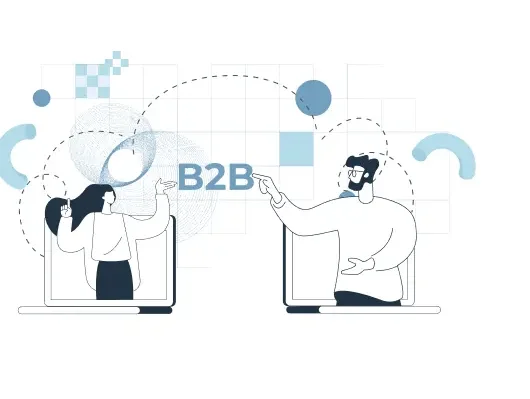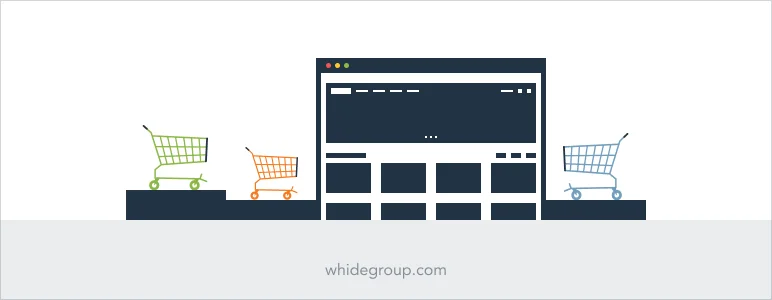10 B2B Ecommerce Trends
That Will Continue to Transform Businesses in 2024

10 B2B Ecommerce Trends
That Will Continue to Transform Businesses in 2024
Share post
In recent years, the booming growth of ecommerce has revolutionized the way businesses operate across various industries. As we approach the year 2024, it is evident that this digital transformation will continue to shape and redefine the B2B business landscape. From the rise of mobile commerce to the growing need of self-service buying, numerous B2B ecommerce trends are projected to dominate over the next few years.
This article delves into some of these key B2B ecommerce trends that are expected to transform businesses in 2024. We explore how advancements in technology, changing consumer behaviors, and evolving market dynamics will contribute to shaping a highly competitive environment for online retailers. By understanding and embracing these emerging trends, businesses can position themselves strategically to thrive in an increasingly digital marketplace.
Table of Contents
ToggleThe mobile-first approach has emerged as a significant trend in the world of B2B ecommerce. With the rapid growth of smartphone usage and increasing reliance on mobile devices, businesses are realizing the importance of optimizing their online platforms for mobile users.
 Source: Statista
Source: Statista
In a mobile-first approach, businesses prioritize designing and developing their websites and applications with mobile devices in mind first, before considering desktop or other platforms. This strategy acknowledges that more and more users are accessing B2B ecommerce sites through their smartphones or tablets rather than traditional desktop computers.
One of the main reasons behind this shift is the convenience provided by mobile devices. Professionals can now access product catalogs, place orders, track shipments, and communicate with suppliers or clients anytime and anywhere without being tied to their office desks. The ability to conduct business transactions on-the-go enhances efficiency, productivity, and responsiveness in the B2B sector.
Moreover, mobile-first design also improves user experience (UX) for customers using smaller screens. Mobile-optimized layouts make it easier to navigate through products, view detailed descriptions, and complete transactions seamlessly. By simplifying complex processes into easy-to-use interfaces on small screens, businesses can enhance customer satisfaction and increase conversion rates.
Another driving factor behind the adoption of a mobile-first B2B ecommerce strategy is search engine optimization (SEO). Search engines like Google have started giving priority to mobile-friendly websites when ranking search results. As a result, companies that optimize their B2B ecommerce platforms for mobile devices not only provide a better user experience but also improve their visibility online.
However, it is important to note that while adopting a mobile-first approach is crucial in the B2B ecommerce space, it does not mean completely neglecting other platforms. Desktop users still form a significant portion of B2B clientele, especially for complex tasks or in certain industries where mobile usage may be limited. Therefore, businesses need to strike a balance between mobile optimization B2B ecommerce strategy and catering to desktop users’ needs.
The mobile-first approach is gaining momentum as one of the trends in B2B ecommerce due to the increasing usage of smartphones and tablets for business transactions. The convenience, improved user experience, SEO benefits, and technological advancements associated with this approach make it an effective strategy for businesses looking to stay competitive in the digital marketplace.
Personalized customer experience is an important B2B ecommerce trend for several reasons.
The importance of personalized customer experience as a trend in B2B ecommerce lies in meeting customer expectations, driving sales and revenue, differentiating from competitors, and improving operational efficiency.
Our list of B2B ecommerce trends can’t miss the point about selling through third-party online marketplaces. It is really important today and there are several clear reasons for it:
As a result, selling through third-party online marketplaces is one of the most importantB2B ecommerce trends in 2024 due to the opportunities it offers for reaching a wide customer base, increasing sales and revenue, gaining market insights, and expanding into new markets.
Selling through social media platforms is indeed a growing trend in B2B ecommerce. In 2024, businesses are expected to continue leveraging social media platforms to connect with customers, promote products or services, and drive sales.
One key advantage of selling through social media platforms is the ability to target and engage a highly specific audience. These platforms offer advanced targeting options, allowing B2B sellers to reach decision-makers and professionals in their industry.
Moreover, social media platforms provide a convenient and seamless customer experience by integrating shopping functionalities. B2B sellers can showcase their products or services directly on their corporate social media profiles and enable customers to make purchases without leaving the platform. This streamlined shopping experience can reduce friction in the buying journey and increase conversion rates.
Furthermore, social media platforms offer powerful analytics and insights that can inform B2B marketing strategies. Businesses can track engagement metrics, such as post reach, likes, comments, and shares, to assess the effectiveness of their social media campaigns. By analyzing these data, B2B sellers can optimize their content, messaging, and targeting to better resonate with their audience and drive higher engagement and conversions.
In conclusion, selling through social media platforms is expected to continue growing as one of B2B ecommerce trends in 2024. It provides B2B sellers with an opportunity to target specific audiences, create personalized experiences, offer a seamless shopping experience, and leverage analytics for data-driven decision-making.
Speaking about B2B ecommerce trends we can’t pass by the importance of omnichannel sales. And here’s why they are important.
Customers want to be able to shop easily online using multiple devices (computers, phones, tablets). They also like the option of being able to pick up or return items in-store if needed. Providing this kind of shopping experience helps make customers happy.
Businesses can improve convenience for B2B customers by giving them different ways to buy things. Customers might like ordering online or talking on the phone with a salesperson, and having these options available helps more people access what they need.
Using an omnichannel approach helps businesses get information about their customers from different places. They can use this info to make the shopping experience better for each customer by sending them messages and deals that fit with what they like. This makes it more likely that a customer will buy something.
If a B2B company can use omnichannel capabilities, it can stand out from other businesses. Not many companies have this technology yet, so using it early on could bring in new customers and keep current ones happy. It also shows that the company likes to change with customer needs.
Collecting information from different sources helps businesses to understand how customers behave and what they like. This is useful for improving marketing, managing inventory better, identifying problems with buying things, and making the business work more efficiently overall.
By adopting the latest B2B ecommerce trends like this one, B2B companies can satisfy customer wants for ease and customization, and also achieve an advantage over the competition.
In 2024, one of the most prominent B2B ecommerce trends we will see the increased adoption of the solutions making business processes more efficient.
Automation is crucial in order processing. B2B orders are often manually entered and prone to errors, but automated systems can reduce manual intervention while ensuring accuracy and speed in fulfilling customer orders. Automated B2B ecommerce can streamline inventory management by tracking and reordering stock levels in real time, preventing stock outs while optimizing inventory and reducing costs.
AI-powered chatbots and virtual assistants can automate B2B ecommerce customer support to provide personalized recommendations, instant responses, track orders/returns while reducing human workload and improving the overall experience.
Automation improves pricing and quoting in B2B ecommerce. AI analyzes data to generate optimized prices or real-time quotes based on predefined rules, allowing businesses to offer competitive prices without manual analysis.
Automated supply chain management is crucial in B2B ecommerce. It efficiently:
By 2024, automating business processes will gain more momentum as a B2B ecommerce strategy. From order processing to customer support and supply chain management, automation increases efficiency and accuracy while saving costs for improved customer experience. Adopting automation gives businesses a competitive edge in the future of B2B ecommerce.
By 2024, B2B ecommerce will prioritize efficient fulfillment to meet customers’ quick and dependable order expectations. Businesses should use this B2B ecommerce strategy in warehouses, streamlining processes like picking, packing, and shipping to reduce errors and improve efficiency.
Companies invest in WMS for optimized inventory storage, movement, and organization using real-time data analytics. This reduces wasted space/handling time and enables faster order fulfillment. Cloud inventory management: This scalable software gives real-time stock visibility across locations, so you can avoid running out of items.
Fast delivery is crucial in 2024. B2B platforms will work with logistics providers offering same/next-day services. Closer warehouses ensure speedy order fulfillment. To streamline operations and speed up order processing, businesses integrate online marketplaces, 3PLs, drop-shippers and warehouses into a single system for better coordination.
Using predictive analytics, businesses can forecast demand patterns to optimize inventory levels throughout the supply chain. Businesses outsource fulfillment to 3PLs or fulfillment companies, allowing them to focus on core competencies and rely on experts for order processing, warehousing, and shipping.
By 2024, B2B ecommerce will use automation, robotics, cloud-based inventory management and outsourcing non-core functions to optimize efficiency. B2B ecommerce trends focus on faster delivery options, integrated channels for fulfillment and predictive analytics for demand planning that adhere to customer expectations.
Headless ecommerce is expected to be a prominent trend in the B2B ecommerce industry. Headless architecture refers to separating the front-end presentation layer of an ecommerce platform from the back-end system. This separation allows businesses to have more flexibility and agility in delivering personalized and immersive customer experiences across various channels.
Here are some reasons why headless ecommerce is likely to gain traction in B2B ecommerce by 2024:
In 2024, headless ecommerce will continue to revolutionize B2B commerce with personalized experiences, agility enhancements and seamless integration.

In 2024, the world of B2B ecommerce is expected to witness significant advancements in payment options. Here are some potential new ecommerce B2B trends in payment processing you should be aware of.
As digital currencies gain wider acceptance and stability, businesses may start accepting cryptocurrencies as a payment option. This would provide faster transactions, reduced fees, and increased security.
P2P payment platforms like Venmo may expand to cater specifically to B2B transactions. These platforms offer convenient and instant money transfers between businesses, eliminating the need for traditional banking intermediaries.
Similar to how BNPL options have gained popularity in B2C ecommerce, this trend could extend to B2B transactions. Businesses might be offered flexible financing solutions such as installment plans or deferred payment terms for purchasing goods and services.
With the rise of mobile commerce, digital wallets like Apple Pay, Google Pay, or Samsung Pay might become more prevalent in B2B ecommerce. These wallets allow businesses to securely store their payment information and make quick purchases with just a few taps on their mobile devices.
The use of blockchain technology can enhance transparency, security, and traceability in B2B transactions. Smart contracts and decentralized finance (DeFi) protocols might facilitate automated payments based on predefined conditions agreed upon by both parties.
Real-time payment systems like Faster Payments (UK) or TIPS (Eurozone) could become widely adopted globally. These systems enable instant fund transfers between banks, providing businesses with immediate access to funds without any delays associated with traditional wire transfers.
Ecommerce platforms might integrate comprehensive payment solutions directly into their platforms, streamlining the buying process for businesses. Such integrated solutions could include features like invoicing, payment gateways, and financial analytics.

The future of B2B ecommerce payments is likely to be characterized by increased speed, convenience, security, and flexibility through the adoption of innovative payment options.
In the rapidly evolving world of B2B ecommerce, staying ahead of market trends is crucial for businesses to thrive. Product discovery is another B2B ecommerce trend called to help companies find potential products or services for customers using digital channels, leading to growth and success. Let’s see which product discovery opportunities are reshaping the landscape of B2B ecommerce and its potential implications for companies seeking growth and competitive advantage.
With advancements in artificial intelligence and machine learning algorithms, B2B ecommerce platforms will offer more personalized product recommendations based on the buyer’s browsing history, purchasing behavior, and preferences. This will enable businesses to discover relevant products that they might not have been aware of otherwise.
B2B ecommerce platforms will invest in improving their search capabilities by implementing natural language processing (NLP) and semantic search techniques. These enhancements will allow buyers to find products more effectively by understanding their specific requirements and providing more accurate search results.
B2B ecommerce platforms will increasingly integrate social commerce features, enabling businesses to discover products through social media channels. This integration will provide an opportunity for companies to showcase their offerings to a wider audience, leading to increased product discovery.
VR technology will become more prevalent in B2B ecommerce, allowing buyers to virtually visualize and experience products before making a purchase decision. This immersive experience will enhance product discovery by enabling businesses to explore different options and variations without physically interacting with them.
Influencer marketing strategies will gain prominence in B2B ecommerce as businesses look for trusted industry experts or thought leaders who can endorse or recommend products. Collaborating with influencers can help create awareness about new or innovative products among potential buyers, leading to increased product discovery opportunities.
AR technology will play a crucial role in B2B ecommerce by offering virtual product trials. Businesses can leverage AR capabilities to allow potential buyers to try out products virtually, eliminating the need for physical samples or prototypes. This interactive experience will facilitate better product discovery as it provides a realistic understanding of the product’s features and benefits.
In 2024, B2B ecommerce will see an increased focus on enhancing product discovery opportunities through personalized recommendations, improved search capabilities, social commerce integration, VR product visualization, influencer marketing, and AR product trials. These advancements will enable businesses to discover relevant products more efficiently and make informed purchase decisions.

B2B ecommerce is the sale of goods/services between businesses through online platforms. It differs from B2C as it involves transactions between companies. It also often includes bulk orders and customized pricing to improve efficiency, reduce costs, & enhance collaboration.
B2B ecommerce sells to businesses, while B2C ecommerce sells directly to consumers. The main difference is the audience and transactions conducted.
Some benefits of implementing a B2B ecommerce platform include increased efficiency, cost savings, improved customer experience, expanded market reach, and better data analytics.
B2B ecommerce can help streamline business processes and improve efficiency by enabling automated ordering, real-time inventory management, faster order processing and fulfillment, seamless communication between buyers and suppliers, data-driven decision-making, and reduced manual errors.
Some key ecommerce features to consider in a B2B ecommerce solution include robust product catalog management, customer-specific pricing and discounts, seamless integration with backend systems (such as ERP), advanced search and filtering options, secure payment gateways, multi-channel support, personalized user experience, and analytics/reporting capabilities.
To ensure the security of your B2B ecommerce transactions and data, you can implement measures such as using secure and encrypted connections, regularly updating your software and systems, implementing strong access controls and authentication mechanisms, conducting regular security audits and penetration testing, educating employees about cybersecurity best practices, and working with trusted partners who prioritize security.
To choose the right B2B ecommerce platform or software for your business, consider factors like your specific business needs, scalability, integrations with existing systems, user-friendliness, security measures, pricing model, and customer support. Conduct thorough research, compare options, and potentially test trial versions to determine which platform aligns best with your requirements.
Yes, it is possible to integrate your existing systems like ERP (Enterprise Resource Planning), CRM (Customer Relationship Management), and other business software with a B2B ecommerce platform. Integration allows seamless data flow between different systems, enabling you to have a unified view of customer information, inventory management, order processing, and more.
Most modern B2B ecommerce platforms provide integration capabilities through APIs (Application Programming Interfaces) or pre-built connectors that can connect with various third-party systems. These integrations can be customized based on your specific requirements and the compatibility of your existing systems.
To attract and retain customers through your B2B ecommerce website or portal, focus on building a user-friendly interface, providing personalized experiences, offering competitive pricing, ensuring efficient order fulfillment and delivery, maintaining strong customer support, and fostering long-term relationships with your clients.
Yes, there are several legal and regulatory considerations specific to B2B ecommerce, such as contracts and agreements, data protection and privacy laws, electronic signatures, intellectual property rights, taxation rules, and industry-specific regulations.
As you can see, B2B ecommerce trends highlighted in the article showcase the evolving needs and expectations of B2B buyers and the strategies that businesses must adopt to stay competitive in the upcoming years. As technology continues to advance and customer expectations evolve, businesses must stay informed about these trends and adapt their strategies accordingly.
If you need any technical help in setting up your B2B ecommerce website and aligning it with the latest trends you are free to contact us. The Whidegroup team is always ready to share our expertise in ecommerce website development, optimization, and customization.
Share This Article

 Shopify Image Optimization: a Guide to a SEO-Friendly and Fast Website
Shopify Image Optimization: a Guide to a SEO-Friendly and Fast Website